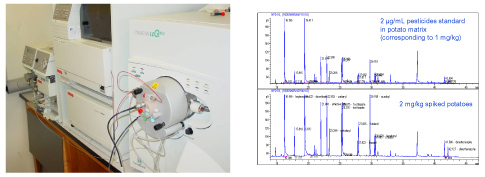Context
Increased demands in the areas of food safety and environmental protection create a requirement in particular for reliable analytical methods for contaminants and other traces of undesirable products to enable food of both animal and plant origin to be analysed or tested as well as components of the environment such as soil, water, sediment and so forth. Pesticide residues are no exception. European and international pesticide residue regulations define parameters and criteria for the validation of analytical methods for pesticide residues.
Objectives
The aim of this project is to develop, optimise and validate analytical methods for pesticide residues in foods of animal or plant origin (fruit, vegetables, cereals) and in the components of the environment (soil, water). The validated methods can then be used to analyse samples for the purpose of residue testing or research projects or for food chain or environmental monitoring. They are also involved in the compilation of registration files as required notably by European legislation governing pesticide marketing in the EU. This work is carried out in accordance with European and international pesticide residue regulations (Directives 91/414/EEC and 96/46/EC, SANCO documents 3029/99, 825/00 and 3103/00, EC Regulation 396/2005, EPA and CODEX/FAO/WHO recommendations) and according to the OECD principles of Good Laboratory Practice (GLP C04 certificate).
Results obtained
Over the past ten years around a hundred analytical methods for pesticide residues in fruit, vegetables and cereals have been developed at the Residues Laboratory. These multi-residue or specific methods cover a whole range of insecticides, acaricides, fungicides, herbicides and growth regulators in various foods: citrus fruits (oranges, clementines), pome fruits (apples, pears), stone fruits (plums, cherries), tropical fruits (bananas, pineapples, kiwis), berries and small fruits (grapes, strawberries, raspberries, gooseberries, blackcurrants, blueberries), fruiting vegetables (tomatoes, cucumbers, gherkins, melons, peppers), root vegetables (carrots, celeriac, turnips, salsify, radishes), bulb vegetables (onions), stem vegetables (leeks, celery), leafy vegetables (lettuces, endives, lamb’s lettuce, spinach, witloof), brassica (round cabbage, cauliflowers, broccoli, curly kale, Brussels sprouts), aromatic herbs (parsley, chives), legumes (beans, peas), mushrooms, potatoes, cereals (wheat, six-rowed winter barley, maize, rape, sunflower, linseed) and industrial crops (sugar beet, chicory). In the last few years analytical methods have also been developed for determination of pesticide residues in animal tissue and fluids (muscle, liver, blood, urine) and in the environment (soil, water, eluates and biofilter substrates).
The laboratory is equipped with all the latest pesticide residue analysis techniques to enable this work to be carried out: gas chromatography-mass spectrometry (GC-MS), gas chromatography-electron capture detection (GC-ECD), gas chromatography-nitrogen phosphorus detection (GC NPD), high performance liquid chromatography with tandem mass spectrometry (LC-MS/MS), high performance liquid chromatography-diode array detection (HPLC-DAD), high performance liquid chromatography with fluorescence detection (HPLC-Fluo), gel permeation chromatography (GPC), solid phase extraction (SPE) and solid support liquid-liquid extraction (SSLLE).
The methods are optimised at each stage of analysis: pesticide extraction with an appropriate solvent, purification of the extract [filtration, centrifuging, liquid-liquid partition, SSLLE, SPE, GPC] and chromatographic determination [GC-MS, GC-ECD, GC-NPD, LC-MS/MS, HPLC-DAD, HPLC-Fluo]. The analytical methods are then validated in accordance with European and international recommendations. The following parameters are determined: specificity, linearity of detector response, matrix effect, repeatability, accuracy (recovery yields), limit of detection (LOD), limit of quantification (LOQ) and pesticide stability in solvents and extracts.
High performance liquid chromatography coupled with mass spectrometry (LC-MS/MS), an advanced technique recently introduced in the laboratory, has led to the development of analytical methods for active substances that are particularly hard to identify and quantify. Due to its sensitivity and specificity this technique opens up interesting new prospects for the future, notably for the newer herbicides and active ingredients which because of their physico-chemical nature are difficult to analyse by gas chromatography.
Most of the analytical methods have been validated in accordance with the OECD principles of Good Laboratory Practice (GLP C04 certificate).
Contribution
The Plant Protection Products and Biocides Physico-chemistry and Residues Unit is responsible for the development, optimisation and full validation of analytical methods for pesticide residues in food and the environment. The Unit submits a full report to the client for the purposes of plant protection product registration or supporting a research project or monitoring data.
Partners
Pesticide manufacturers, including prominent multinationals as well as local or international generic manufacturers.
- Federal Public Service Public Health, Food Chain Safety and the Environment.
- Codex Alimentarius committee on pesticide residues FAO/WHO).
Funding
- CRA-W - Walloon Agricultural Research Centre
- SPF Public Health











